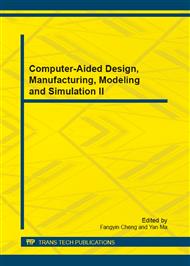p.1154
p.1158
p.1165
p.1170
p.1175
p.1181
p.1186
p.1190
p.1194
Simulation Analysis of Coating at Uniform Velocity of Robotic Spray Gun
Abstract:
Coating uniformity model was developed to optimize spray painting robot trajectories, assuming uniform robot motion and a parabolic spray distribution with uniformity evaluated based on the thickness variation. Dimensionless calculation results show that overlapping distance is a major influencing factor of mean coating thickness, and that seed path position and work piece width are secondary ones. Overlapping distance is a critical influencing factor of coating uniformity, but seed path position and work piece width exert little influence on coating uniformity. Minimum thickness variance is about 0.0025 if overlapping distance is between 0.29 and 0.31. Thus, Overlapping distance should be taken into account to plan robot trajectory for spray painting, but seed path position and work piece width could be neglected.
Info:
Periodical:
Pages:
1175-1180
Citation:
Online since:
December 2012
Authors:
Keywords:
Price:
Сopyright:
© 2013 Trans Tech Publications Ltd. All Rights Reserved
Share:
Citation:


